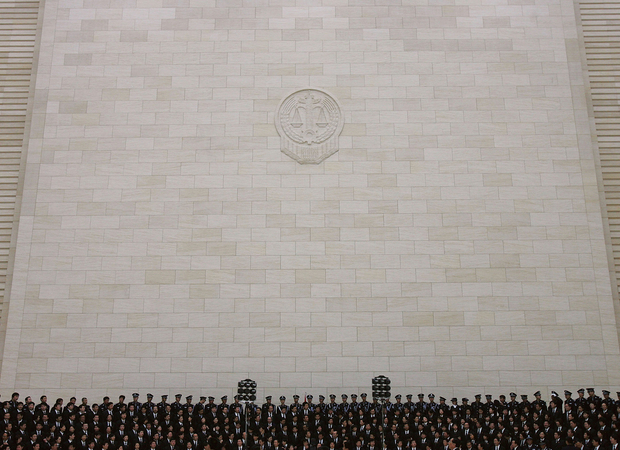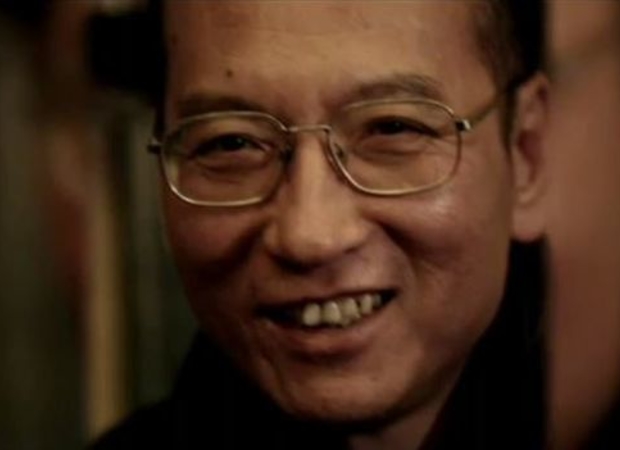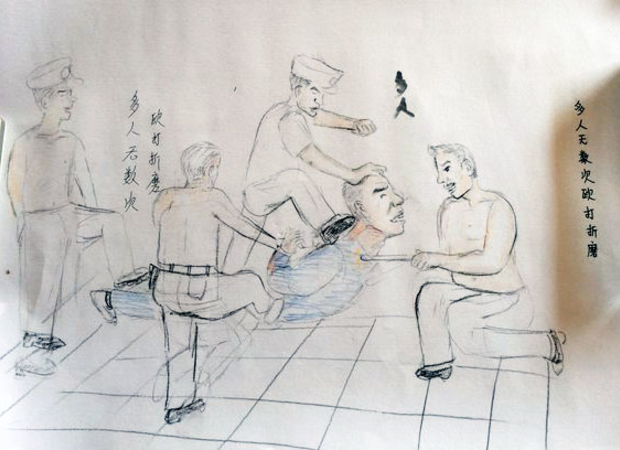SOL: This year old article from SEPTEMBER 8, 2016 about Trump by an excellent International journalists Finian Cunningham, was an accurate forecast of Trump’s political future. HOWEVER, the American “establishment's” MSM has assaulted Trump with every possible political weapon available for a year now and not only has Trump survived against attacks from members of both political parties, but even impossible odds to still became President of the United States. What could eventually turn HIS American voters against him just may end up being his own doing. The Neocons and members of the “establishment” that he has chosen to surrounded himself is steering him into huge obstacles causing too much confusion as to his position on real issues. It seems that Trump has now taken a detour from his original bumpy “road to change” to an old worn country road so deeply grooved that makes it very difficult to steer his administration out of this establishment’s very deep ruts. It makes those that put him into the White House to begin questioning what direction he is attempting to lead us and if we will still be ruled by the same “Deep State” we voted against. ONLY TIME WILL TELL!Political Assassination - the American Way© AP Photo/ Mic Smith16:18 09.08.2016 Get short URL3213305843Donald Trump has entered a political kill zone. And the American establishment is lining up to take him out. We are talking here in virtual terms - at least thus far.Nowadays, political assassination by US powers-that-be does not necessarily involve physical liquidation of the individual deemed to be an enemy of the state. Who needs all that blood and controversy? Especially when character assassination achieves the same desired end result — that is, elimination of target from the public domain.The fierce media crossfire that the Republican presidential contender is being subjected to leaves little doubt that this is a concerted effort to destroy this politician.In the past week, we have seen a fusillade of vilification fired at the New York property tycoon-turned presidential hopeful. Everything, it seems, has been thrown at him, from his Slovenian-born wife's alleged US visa violations, to his bullying of crying babies at rallies, to his serving as an unwitting agent for Russian leader Vladimir Putin.It's so transparent and preposterous, it is almost hilarious.Evidently, the US corporate news media are out to bring Trump down in spite of his stubborn support among ordinary Republican voters. It is obvious that the Washington establishment has determined that Democrat rival Hillary Clinton is the preferred choice to protect their privileged interests as the next occupant of the White House.And the US media — as a pillar of the establishment — is doing its bit to eliminate Trump from the supposedly free presidential election due in November by aiding and abetting in assassinating his character in the eyes of the public.It is ironic really given that there is so much more sordid stories to be reported on Clinton, given her involvement in warmongering, clandestine regime-change operations and abuse of state secrecy for her own self-aggrandizement with foreign sources of money.The latest sign that the secretive US Deep State — Pentagon, CIA, FBI, Wall Street financiers — is moving to install their White House candidate is the letter published this week by some 50 senior Republican "national security experts" who endorsed Clinton while eviscerating Trump.Yes, that's right, Republicans backing a Democrat. Which just goes to show the uniformity of interests.The signatories included former CIA director Michael Hayden, ex-chief of homeland security Michael Chertoff, both of whom served in the George W Bush administration, as well as John Negroponte who was a former director of national intelligence and alleged purveyor of death squads in Central America during the 1980s.The joint anti-Trump letter followed the publication only days ago of an oped piece in the New York Times by another ex-CIA head, Michael Morell in which he lambasted Trump as a Russian stooge.All of these figures are intimately connected to the US Deep State and all are unanimously pillorying Trump as a "dangerous threat to American national security".For his part, Trump rebuffed the latest volley of vilification by saying that the list of national security "experts" are responsible for creating the Iraq war, the loss of American troops' lives and the rise of terrorism across the Middle East. Cheekily, he thanked them for all going public with their names so that the American people can hold them to account for foreign policy disasters.However, the point here is that the campaign to discredit Trump is not just some haphazard run of bad luck on the candidate's part for mis-steps and mis-speaks that he may have issued on the hustings trail.The intense, concerted nature of the campaign to destroy Trump demonstrates how the Washington power structure, including the corporate media, is setting him up for character assassination.This is the kind of political liquidation that the American plutocracy excels at.A few decades ago, American "executive action" — or "termination with extreme prejudice — involved, more often than not, literally murdering the individual target.The most notorious case is that of President John F Kennedy who was assassinated on November 22, 1963, in Dallas. Around that time, several other foreign political leaders were also killed by American state agents, including Patrice Lumumba of Congo, Rafael Trujillo of Dominican Republic and Ngo Dinh Diem of South Vietnam. Political murder was, still is, par for the American course.The late New Orleans attorney, Jim Garrison, who probed the JFK assassination, said that the primary reason for his murder was that the president was working to end the Cold War with Russia. Kennedy was quietly using backchannels with Russian counterpart Nikita Krushchev to implement ambitious plans for nuclear weapons disarmament.JFK had also flatly rejected secret proposals presented by the Pentagon for a pre-emptive nuclear strike on the Soviet Union. He was in addition closing down CIA-sponsored terrorist operations in Cuba and he had declared a withdrawal of US troops from the nascent Vietnam war.In this way, Kennedy had entered the political kill zone, as far as the powerful, unelected Deep State was concerned. His policies were threatening huge vested interests of military manufacturers, Big Oil and Wall Street financiers. Hence, the CIA and its contract killers were deployed to eliminate the "problem".Donald Trump shares two aspects with JFK. Like Kennedy, the business magnate is independently wealthy, which allows him to speak his mind without apparently having to ingratiate himself with powerful sponsors.Secondly, and more importantly, Trump has repeatedly pitched his election platform against the relentless build up of the US-led NATO military alliance in Eastern Europe, as well as overseas deployment of American forces, and, in particular, Washington's policy of hostility towards Russia.Trump has called for the normalization of relations with Russia. His foreign policy position is anathema to the Washington establishment which requires — as an absolute necessity — the demonization of foreign countries as "national security threats" in order to maintain the gargantuan US militarized economy. In short, the American Deep State thrives on continual war-making. War is a permanent function of bankrupt American capitalism.This systemic dysfunction is what the Cold War with Russia was and continues to be about — the pumping of trillions of dollars into corporate and financial elites, who get away with the scam because of their lackeys among the political and media channels.Anyone who defies these powerful American interests is liable for termination. They have entered the kill zone.In former times, the American methods of termination with extreme prejudice routinely involved physical elimination.Five decades after JFK, the US methods of political assassination have evolved to become more sophisticated. Character assassination may suffice most of the time. No need for contract hitmen or messy public enquiries. Media hitmen will do.The target just needs to be placed in the crossfire of a media barrage, with no let up in negative shots.Any foreign leader who likewise becomes a "problem" for US power interests is also targeted similarly. Russia's President Putin being perhaps the best example of this.As the US presidential election approaches over the next three months, just watch how the shadowy powers in Washington mobilize to take Trump out of the race.For taking out political enemies with extreme prejudice is the American way.
Dissident activist Chen Xi entered Xingyi
Prison in Guangxi in January 2012 to serve a 10-year sentence. The
previous month, he had been convicted
of “inciting subversion of state power” for writing articles about
human rights and democracy. This wasn’t Chen’s first time in jail. He’d
already spent a total of 13 years in prison, including three for
participating in the 1989 pro-democracy movement. So to some extent, he
was prepared for what lay ahead. But this prison term would be
different.
Within a month, he had contracted
frostbite on his hands after prison guards refused to give him warm
clothes and blankets during the unusually cold winter. After two years,
Chen began to suffer
from chronic enteritis, a treatable inflammation of the digestive tract
normally caused by contaminated food or drink. But Chen didn’t receive
treatment. In December 2013 he began to have frequent bouts of severe
diarrhea. When his wife visited him
in mid-2014, he was extremely weak due to dehydration and fever, had
lost a considerable amount of weight, and was in a poor mental state. By
December of that year, Chen was psychologically distressed. By then, he
had been suffering from untreated diarrhea for a year and had been
repeatedly placed in solitary confinement. The prison has refused to
grant him medical parole and reportedly told Chen’s wife it never would, despite its inability or unwillingness to treat him.Disturbingly, Chen’s case is not an outlier. Dozens of political detainees and prisoners have reported being deprived of adequate medical treatment. These cases raise the question of what kind of treatment Nobel Peace Prize Laureate Liu Xiaobo received before his death in July 2017 due to complications from liver cancer. Chinese security agents and propaganda officials went into overdrive before and after his death, attempting to paint a picture that Liu received the best available medical care. However, during Liu’s seven years at Jinzhou Prison in Liaoning Province, authorities knew that Liu had hepatitis B, a disease that put him at greater risk for liver cancer. Yet, Liu’s cancer was so advanced when he was granted medical parole and moved to a hospital that no surgery, chemotherapy, or radiation therapy could be performed, according to his wife, the poet Liu Xia.
Chinese law mandates that prisoners and individuals held in detention facilities receive prompt medical care; however, the reality is often far removed from the law. Deliberately depriving prisoners of medical care is a life-threatening form of torture, and appears to be commonly used against political prisoners on China. Many of these cases follow a similar pattern, starting with a decline in health from existing conditions or new injuries emerging due to torture or ill-treatment, denied access to adequate and prompt medical care, and a refusal to approve applications for medical bail or parole. Family members worry that the government will simply let their loved ones die behind bars; the death of China’s most famous political prisoner in police custody only strengthens that fear.
Another pressing case of deprived medical treatment is that of rural women’s rights activist Su Changlan. Su was detained in 2014 after posting social media messages in support of the Occupy Hong Kong pro-democracy protests. Authorities in Guangdong’s Foshan City arrested and charged Su with “inciting subversion of state power,” accusing her of trying to “overthrow the socialist system” with her articles and comments on WeChat. Su suffers from hyperthyroidism, which can be fatal if not treated. In custody, she has suffered from complications from a lack of treatment, including heart arrhythmia, trembling hands, swollen eyes, weight loss, and incontinence. Su told her lawyers in meetings throughout 2015 and 2016 about the poor or non-existent medical care she had been receiving, as well as the poor hygiene and living conditions.
The risk of death from deprived medical care is very real. On March 14, 2014, human rights activist Cao Shunli died after being deprived of medical treatment for over six months in a Beijing detention center. Police seized Cao, who had several manageable health conditions, in September 2013 to prevent her from traveling to Geneva to testify to the U.N. Human Rights Council about the human rights situation in China. Cao had a liver condition that she had managed in the past, but guards reportedly confiscated medication that she had with her. While Cao was held in a detention center, her health began to deteriorate, but authorities refused to approve her lawyers’ requests for medical bail. It was not until she was practically in a coma that bail was approved, and Cao died from organ failure only 22 days later. Other individuals who challenged the government and have died after being deprived of medical care in custody include petitioner-activists Chen Xiaoming and Duan Huimin in the mid-2000s, and more recently Tibetans Goshul Lobsang and Tenzin Delek Rinpoche.
The international community has spoken out about deprivation of medical treatment as a form of torture used against China’s political prisoners. U.N. human rights experts, in calling on China to provide adequate medical care for activist Guo Feixiong in August 2016, felt that, “His public profile as a human rights defender seems to have been the cause and aggravating factor for the denial of appropriate medical care and ill-treatment.”
Chinese President Xi Jinping has promised to “govern the country according to the law,” but the pattern of deprived medical care shows a disregard for the lives of human rights defenders and a lack of rule of law. Legislation requiring “prompt medical treatment” are not implemented, and other regulations and rules are deficient because they don’t contain legal guarantees that doctors in prisons or detention facilities can make independent medical decisions without interference from either law-enforcement or Chinese Communist Party (C.C.P.) officials.
Securing release for medical reasons is also difficult. China’s Criminal Procedure Law allows for detainees and prisoners to receive medical bail or parole due to “serious illness.” However, the scope of what constitutes “serious illness” under detailed measures released in 2014 is extremely restrictive and requires some prisoners to endure six months of failed treatment before they can be eligible. Some Chinese lawyers who take on “politically sensitive” cases have reported that C.C.P. bodies, not medical professionals, must approve applications for medical release.
China has obligations under international law to ensure prisoners and detainees have access to prompt and adequate medical care, including seeing a doctor of their choice. Since 1988, China has been party to the Convention Against Torture, which bans torture and cruel, inhumane, and degrading treatment. In December 2015, the U.N. Committee Against Torture raised concern over deaths in Chinese custody as a result of a lack of prompt medical care. A year prior, two other U.N. committees, on economic, social, and cultural rights and on women’s rights, called on China to ensure women in detention and human rights activists are provided with adequate health care in all circumstances, in respect of China’s treaty obligations.
China’s fellow members on the U.N. Human Rights Council should pressure the government to cooperate with the Council’s own independent human rights experts, who have highlighted concerns over the deprivation of medical care to human rights defenders. Such experts should be allowed, as some have in the past, to independently visit China’s prisons and detention centers to report on the standard and care of medical treatment. Other governments can and should continue to forcefully and publicly call on China to abide by its international obligations on torture and human rights. China’s respect for its responsibilities under international law is a matter of global concern.
As Dostoevsky famously wrote, “The degree of civilization in a society can be judged by entering its prisons.” In China, as seen in the cases of Chen Xi, Su Changlan, Cao Shunli, and so many others, the government refuses to behave in a civilized manner when it tortures prisoners of conscience by depriving them access to adequate medical treatment.




